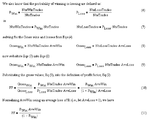A lot of people want to compare their trading system with that of other people. To achieve this we need to calculate the expectancy of the system over the long term rather than just saying I made 100 pts last week and x made 50 pts therefore my system is better.
The best way to calculate expectancy is take a reasonable number of actual trades (at least 100) and calculate the following based on those results:
Average Win Size (AW) = The average of all trades which won (do not count the biggest win and do not count breakeven trades)
Average Loss Size (AL) = The average of all trades which lost (again do not count any breakeven trades)
Average Win Percentage (W%) = total winners/total number of trades excluding breakeven trades and the biggest winner
Average Loss Percentage (L%) = 100%-W%
Average number of trades per year (T) = number of trades in the sample size/number of weeks the sample covers * 52
Expectancy = ((AW*W% + AL*L%) / - AL ) * T
Attached is an Excel S/S with the formula in to help you.
Here are the figures for my trading system that I use on the E-mini S&P:
AW=10.79pts
AL=(5.14)pts
W%=51%
L%=49%
T=400
My expectancy is 232. So for each $1 I risk on every trade I expect to make $232 in a year.
Obviously the higher the expectancy the better, if it is negative then you will be losing money and should reevaluate your system.
I hope this helps people when they are designing their own systems and looking for comparisons.
Tim
The best way to calculate expectancy is take a reasonable number of actual trades (at least 100) and calculate the following based on those results:
Average Win Size (AW) = The average of all trades which won (do not count the biggest win and do not count breakeven trades)
Average Loss Size (AL) = The average of all trades which lost (again do not count any breakeven trades)
Average Win Percentage (W%) = total winners/total number of trades excluding breakeven trades and the biggest winner
Average Loss Percentage (L%) = 100%-W%
Average number of trades per year (T) = number of trades in the sample size/number of weeks the sample covers * 52
Expectancy = ((AW*W% + AL*L%) / - AL ) * T
Attached is an Excel S/S with the formula in to help you.
Here are the figures for my trading system that I use on the E-mini S&P:
AW=10.79pts
AL=(5.14)pts
W%=51%
L%=49%
T=400
My expectancy is 232. So for each $1 I risk on every trade I expect to make $232 in a year.
Obviously the higher the expectancy the better, if it is negative then you will be losing money and should reevaluate your system.
I hope this helps people when they are designing their own systems and looking for comparisons.
Tim






